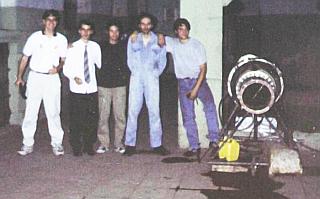 In 1987 Fuerza Aerea Argentina donated to the Engines' Laboratory
two Turbomeca Marboré IIc turbojets, but the
impossibility to obtain the operation and maintenance manuals (Due to the
National Security Doctrine) set a restraint to the attempts to start at least
one of them. From a casual chat in the first weeks of 1999 regular classes
period between Eng. Alvarez (Chief of the School's Engines Laboratory) and Mr.
Treviño of School's Technical Office settled down the possibility of obtaining the manuals through the
Area Material Quilmes. Months later, when the 6th Year students who
had generated the questions that gave origin to the section "Happened in
1982... " found out that the manuals were within the Establishment,
they did not loose time in making the proposal: to start one of the turbojets.
In 1987 Fuerza Aerea Argentina donated to the Engines' Laboratory
two Turbomeca Marboré IIc turbojets, but the
impossibility to obtain the operation and maintenance manuals (Due to the
National Security Doctrine) set a restraint to the attempts to start at least
one of them. From a casual chat in the first weeks of 1999 regular classes
period between Eng. Alvarez (Chief of the School's Engines Laboratory) and Mr.
Treviño of School's Technical Office settled down the possibility of obtaining the manuals through the
Area Material Quilmes. Months later, when the 6th Year students who
had generated the questions that gave origin to the section "Happened in
1982... " found out that the manuals were within the Establishment,
they did not loose time in making the proposal: to start one of the turbojets.
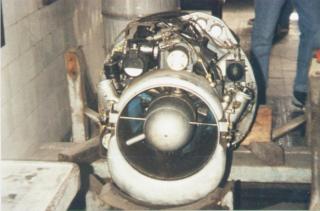 The works began two days later than in 1982 (On October 19th of
1999) with the students Jorge Radesca and Roberto Laterra (to whom
Alejandro Flagel would join later), under the direction of Technology II M.E.P. Gustavo D. Vranjes and
the Chief of Engines' Laboratory Ernesto C. Alvarez.
The works began two days later than in 1982 (On October 19th of
1999) with the students Jorge Radesca and Roberto Laterra (to whom
Alejandro Flagel would join later), under the direction of Technology II M.E.P. Gustavo D. Vranjes and
the Chief of Engines' Laboratory Ernesto C. Alvarez.
The first task accomplished with the help of the manuals was to verify whether we have at hand something that could be started. We already knew that we did not have JP-1, turbines' oil, ignition and control auxiliary systems, jet exhaust tube and a frame where to hold the turbojet.
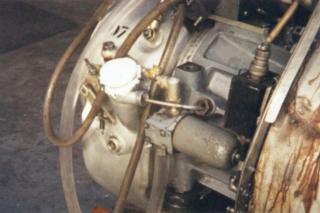 With the lessons learned in 1982 and a not very encouraging panorama
(End of regular classes period was also very close) we decided that it did not
matter how far we could go, it was no use to try anything
without a good movable metallic base frame that could allow us to change the
location of the turbojet as much as we needed. We had one general idea about
was necessary, the only doubts were about how high was advisable to make it in
order to be able to work in a comfortable way on the machine, how long was
convenient to make it in case it was necessary to support the nonexistent (until
the moment) exhaust jet tube and the convenience (or not) of
integrating to the metallic base the JP-1 tank to facilitate the
transfer of the whole unit. Of all the mentioned doubts this last was the
greater one.
With the lessons learned in 1982 and a not very encouraging panorama
(End of regular classes period was also very close) we decided that it did not
matter how far we could go, it was no use to try anything
without a good movable metallic base frame that could allow us to change the
location of the turbojet as much as we needed. We had one general idea about
was necessary, the only doubts were about how high was advisable to make it in
order to be able to work in a comfortable way on the machine, how long was
convenient to make it in case it was necessary to support the nonexistent (until
the moment) exhaust jet tube and the convenience (or not) of
integrating to the metallic base the JP-1 tank to facilitate the
transfer of the whole unit. Of all the mentioned doubts this last was the
greater one.
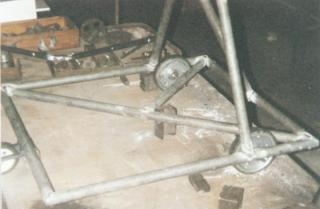 With the materials that we could obtain thanks to the School's Chief of Mechanics
Superior Cycle workshops, Mr. Alfredo Seguí; we began the construction more
slowly than we needed and wanted, because given the nature of the enterprise and the real possibility to
have again to stop the works at any time by some unsalvable difficulty
we decided not to request to work within our normal working hours and to
finance ourself the expenses that the adventure would originate.
With the materials that we could obtain thanks to the School's Chief of Mechanics
Superior Cycle workshops, Mr. Alfredo Seguí; we began the construction more
slowly than we needed and wanted, because given the nature of the enterprise and the real possibility to
have again to stop the works at any time by some unsalvable difficulty
we decided not to request to work within our normal working hours and to
finance ourself the expenses that the adventure would originate.
Thus we worked every day two hours after our normal working hours until December 10th, in this day which the students ended their regular classes. From then on we could have more time to continue with the necessary workings. (In 1982 we worked ten hours daily normally...)
The result of the inspection recommended by the manuals was more than good if we could not consider for a moment everything what we needed, so Mr. Treviño arranged as soon as was possible a visit to the Technical School Taller Regional Quilmes on November 4th. Again we were received with the same cordiality as in 1982 by Professors L. Calienni and J. Juarez and again they were our "blind person's guide" in the problems that manuals did not covered. We would need to open another section to write about its recommendations, but we came back with the security that with the things we had at hand it was possible to make a good attempt. Good part of the conversation turned around the exhaust jet tube that was not possible to obtain any longer. It was necessary to make it and they gave us the dimensions of the only one that they have in use.
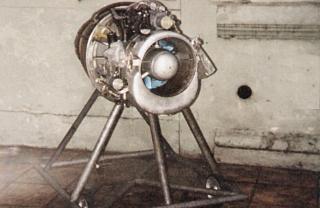 The first 30 days passed slowly with the welding work of the tubes of
the metallical base frame, although without great problems to end it.
On the fly (and after having seen the facilities in the Area Material
Quilmes) it was decided that the fuel tank would not be integrated to the
assembly. Once finished it was transferred on its wheels to the School's
Engines' Laboratory and there turbojet 1076 was mounted on it.
Some maneuvers within the Laboratory showed that the height of
the new metallic base frame was good, that it moved with extreme
easyness in the transfer and that the tail wheel which we adapted to the
same would not support for a long time the approx. 80 kgf load that it
received. On the following day we made a general cleaning of the assembly with a
hidrojet cleaner that caused it to look just as factory new. We also noticed
the easiness with which the machine shaft spun when the pressurized water
struck the compressor and turbine blades...
The first 30 days passed slowly with the welding work of the tubes of
the metallical base frame, although without great problems to end it.
On the fly (and after having seen the facilities in the Area Material
Quilmes) it was decided that the fuel tank would not be integrated to the
assembly. Once finished it was transferred on its wheels to the School's
Engines' Laboratory and there turbojet 1076 was mounted on it.
Some maneuvers within the Laboratory showed that the height of
the new metallic base frame was good, that it moved with extreme
easyness in the transfer and that the tail wheel which we adapted to the
same would not support for a long time the approx. 80 kgf load that it
received. On the following day we made a general cleaning of the assembly with a
hidrojet cleaner that caused it to look just as factory new. We also noticed
the easiness with which the machine shaft spun when the pressurized water
struck the compressor and turbine blades...
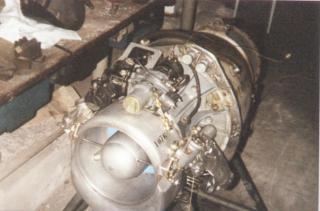 48 hs. later was necessary to remake a pair of weldings and to replace
the frame's tail wheel by another similar to those we had already installed.
There is not nothing perfect...
48 hs. later was necessary to remake a pair of weldings and to replace
the frame's tail wheel by another similar to those we had already installed.
There is not nothing perfect...
Meanwhile and step by step we were thinking about how to solve the possibly more serious problem that we had until the moment: the exhaust jet tube.
Although we counted on the exact measures provided by Area Material Quilmes' people and a good idea of how much (or not) we could apart from them, there existed the problem of how to make it with the elements that could be found within the Establishment. We only had galvanized plate of 0,4 millimeters thickness, so by obvious reasons we discarded the unions by welding and also those of screws for the hot zones (~700 °C). After several consultations it was chosen to use riveted joints. Would it be good enough?. After all, at this stage of events we did not know if really the machine could be started.
So the construction of the exhaust jet tube became a non prioritary work, for those "free times" (meaning it: dead times) that we could not take advantage of during the regeneration of the ignition system. And inevitably, from the proposed sequence of work, a series of questions arose of which answers we depended to reach (or not) the proposed goal.
Question number one: Does the auxiliary ignition system work?
In order to verify it we needed two 12 Volts batteries and had only one at hand. Would it be possible to make verifications with just only one?. Luckily yes and apparently the vibrators and spark plugs seemed to work OK. Good news. But we already knew from 1982 that one thing is to make sparks in a test and another one to obtain the ignition of the machine, so we would try to borrow one second battery as fast as we could to make one more test closer to the real conditions of use.
Question number two: Does the auxiliary starting motor work?
With the same limitations concerning the lack of one battery, and remembering the original recommendations of Mr. Nestor Turró in 1982 about the circuit necessary to carry out the test, we discovered that the original electrical board constructed to start the Rolls-Royce Derwent V turbojet that was stored in the School's Electrical Measurements Laboratory had been dismantled and put in a dump body some years before!. Very bad news, since due to the lack of time and materials we thought to adapt this one to try the starting of the Marboré. But yet, still we did not have an answer to the question number two.
It was more than dangerous to connect directly the electrical motor with the 12 Volts battery (the result could be a breakage of the force transmission mechanism and/or the motor's winding burnt). So investigating before making any other thing we measured with a tester the resistance on the tips of the auxiliary electrical motor. Zero. Would it give the same result a measurement on the piece corresponding to the other turbojet?. No!. That meant that... the starter engine of turbojet 1076 did not work and had to be replaced!. Luckily we could count on one second machine that could be cannibalized, and still the replaced electrical motor had not even been tested doing its work...
Question number three: Does the auxiliary ignition fuel pump work?
Again, test conditions similar to the previous ones. The pump shaft rotated but it did not pump fuel. Would it be obturated somewhere?. A careful dismantel of it would show that no. May voltage applied not be sufficient? (The working voltage of the pump is 24V). The answer was no. Had we a spare pump on the other turbojet. Another time no!
|
We had reached the end of the enterprise unless:.
1. We could find another pump at least lent. Ideal but less probable in the few days that we had left before the regular classes period end. 2. Was it possible to adapt the auxiliary fuel pump of Derwent V to the Marboré. At least the physical adaptation to the ignition system could be made without major problems... |
Question number four: Would it be possible then for the adapted pump to work suitably and serve to feed the machine's ignition torches?.
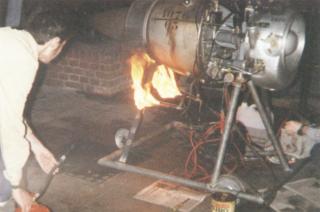 There was not another form to verify this that mounting everything
outside the machine and to simulate the first stage of ignition with
24 Volts and a modified fuel system supply. We proceeded with the proper
precautions and knowing that if this did not work,
good bye (at least for a good time) to the adventure.
There was not another form to verify this that mounting everything
outside the machine and to simulate the first stage of ignition with
24 Volts and a modified fuel system supply. We proceeded with the proper
precautions and knowing that if this did not work,
good bye (at least for a good time) to the adventure.
At the first attempt we could verify immediately that the installation worked but that there was not spark in one of the ignition torches. We changed the corresponding vibrator, made some adjustments and there was auxiliary ignition system!. First indication that things could work after some serious problems. A French turbojet using an adapted starting pump from an English one and an exhaust jet tube Made In Krause. Better not to think about all this and to continue work in the things that we lack...
Question number five: Would it be possible that the electrical auxiliary starting motor to be used without the corresponding starting installation, since it seemed to be in good state?.
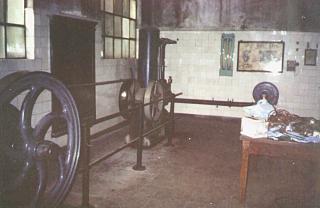 The observation of the easiness with which the turbine shaft rotated when the
water of the hydrojet cleaner reached its blades during the washing, with the added knowledge of that an
appreciable amount of energy could be accumulated within a compressed air tank
which is used in tests within the School's Engines Laboratory; led to think about
the possibility of using this as a mean to move the turbine
during the starting cycle. The first attempt was a complete failure. As it was
tried to force the compressed air entrance to the turbine (through the
compressor's hot air exit), the machine shaft did not rotate. Without too much
conviction it was tested to blow air directly on the entrance of the compressor.
Only 100 of the necessary 1200 RPMs for a starting attempt were obtained...
After thinking for a while, it was supossed that perhaps changing the incidence
of the incoming air on the compressor, a higher number of RPMs could be obtained. Since we were at
only three days of the regular classes period end, the solutions had to be
fast and simple. The hollow leg of a broken chair turned out to be the
device we were looking for. New test and this time 300 RPMs were reached with the
more than pleasant surprise that turned out to see that the lubrication system
already worked at that regime. But the main fuel pump did not gave life signals...
The observation of the easiness with which the turbine shaft rotated when the
water of the hydrojet cleaner reached its blades during the washing, with the added knowledge of that an
appreciable amount of energy could be accumulated within a compressed air tank
which is used in tests within the School's Engines Laboratory; led to think about
the possibility of using this as a mean to move the turbine
during the starting cycle. The first attempt was a complete failure. As it was
tried to force the compressed air entrance to the turbine (through the
compressor's hot air exit), the machine shaft did not rotate. Without too much
conviction it was tested to blow air directly on the entrance of the compressor.
Only 100 of the necessary 1200 RPMs for a starting attempt were obtained...
After thinking for a while, it was supossed that perhaps changing the incidence
of the incoming air on the compressor, a higher number of RPMs could be obtained. Since we were at
only three days of the regular classes period end, the solutions had to be
fast and simple. The hollow leg of a broken chair turned out to be the
device we were looking for. New test and this time 300 RPMs were reached with the
more than pleasant surprise that turned out to see that the lubrication system
already worked at that regime. But the main fuel pump did not gave life signals...
Even so, 300 RPMs still was very below the 1200 RPMs necessary for a starting attempt.
At the following day (only two were left) we tried something that was thought about in the previous days (since we did not have other alternatives at hand...): that we could try "a mixed" starting, with compressed air used to begin to rotate the turbine shaft, and when the number of RPMs produced by the compressed air began to decay; immediately connect the electrical motor to increase the number of RPM with the only 12V battery that we had at hand. The result of the first attempt was more than promising: 700 RPMs with a battery less!. Then, we decided to buy a pair of 12 Volts batteries to carry out the first serious attempt of starting without formal auxiliary systems...
While waiting for the arrival of the new batteries, we dedicated ourselves to do some minor adjustments, and "to prepare" 120 liters of JP-1 (80% kerosene that we used to start the Engines' Laboratory Electrical Power Station plus a 20% of super gasoline, according to indications of the people of E.T. Taller Regional Quilmes; to that we added a 1% of SAE 10 oil according to indications of the operation manual, due to the impossibility to obtain turbines' oil in the time we had left)
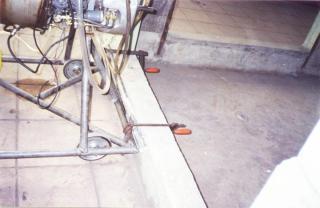 December 17th was the last day of the regular classes period, and we were notified
that the batteries would arrive at 5:30 PM. The fact of being practically
alone within the establishment by the reason before mentioned still made more
attractive the day to make a first starting attempt.
December 17th was the last day of the regular classes period, and we were notified
that the batteries would arrive at 5:30 PM. The fact of being practically
alone within the establishment by the reason before mentioned still made more
attractive the day to make a first starting attempt.
We prepared everything from the morning and filled the tank with the JP-1 "made in Krause". Again like almost 20 years ago, most of the authorities of the Establishment knew that this was the day of the first serious starting attempt. And same as before, we were the first in doubt of our possibilities. Even conjectured (it was Friday) that would be advisable for us to "move away from the subject" a couple of days to return Monday with the mind more distressed and perhaps we could see details that could have been ignored in the hurry to finish just in time.
Nevertheless, two of the three members of the 6th. year workgroup had dates to fulfill during the following week, so it was decided that if the batteries arrived on time, the first starting attempt would be made on that day.
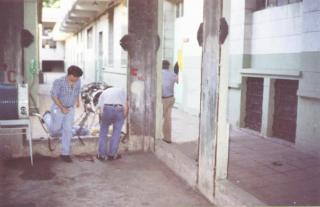 The batteries arrived at 5:45 PM and on the fly at suggestion of a friend who obvious
knew more than us on the subject some modifications to the "electrical circuit" were
made (Remember: we are Mechanical Technicians and Néstor Turró was
no longer with us...). At this point we took a 15 minutes rest to try to
distender us the maximum possible given the circumstances of the moment before
trying the first starting.
The batteries arrived at 5:45 PM and on the fly at suggestion of a friend who obvious
knew more than us on the subject some modifications to the "electrical circuit" were
made (Remember: we are Mechanical Technicians and Néstor Turró was
no longer with us...). At this point we took a 15 minutes rest to try to
distender us the maximum possible given the circumstances of the moment before
trying the first starting.
We met at Engines' Laboratory (altogether we were seven people) where we reviewed by nth time the play for each one, mainly in the case of some unexpected thing. Also we counted as participants-spectators-fans all the personnel of the School's Mechanics Superior Cycle workshops, since we were located at less than 10 meters from its workplace.
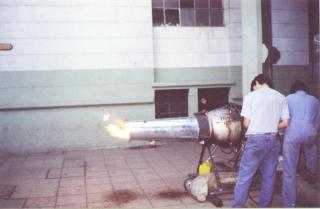 Being 7:03 PM we began the starting sequence,
and after some seconds the RPMs' counter transmission broke. Due to the advanced
state of the sequence we decided on the fly not to abort it. We used as a
reference the amperage consuption of the starting electrical motor and supposed that we had the maximum RPMs, whatever it was, when the meter
reached its minimum and stabilized reading.
Being 7:03 PM we began the starting sequence,
and after some seconds the RPMs' counter transmission broke. Due to the advanced
state of the sequence we decided on the fly not to abort it. We used as a
reference the amperage consuption of the starting electrical motor and supposed that we had the maximum RPMs, whatever it was, when the meter
reached its minimum and stabilized reading.
Then we opened the main valve of the fuel tank and a 1,50 meters flame was seen, followed by the expulsion of kerosene still without burning by the jet exhaust tube. A couple of times it was tried in vain to cause the motor to increase the number of RPMs, so we cut off the JP-1 feed and this was the end of the first attempt. (In the shot it can be seen that the length of the flame is much smaller than mentioned because our photographer "was surprised" by the rapidity of the events.)
Our "fans" quickly came to congratulate to us, but we were not in agreement. It was evident that we had hurried to open the JP-1 feeding to the engine and we had flooded it.
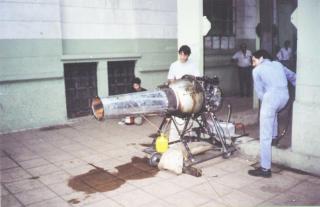 Then we modified and reaconditionated the measurement system of RPMs
and tried a start for the second time at 7:20 PM. Like in 1982, when
the starting sequence was complete and there were no evident signs of
the engine start-up, we ended it; and with the sound of
a smooth deflagration at the beginning, and with an acute whistle later,
the turbojet climbed stable and up by its own means from 1200 RPMs until
(we estimate) 6000 RPMs.
Then we modified and reaconditionated the measurement system of RPMs
and tried a start for the second time at 7:20 PM. Like in 1982, when
the starting sequence was complete and there were no evident signs of
the engine start-up, we ended it; and with the sound of
a smooth deflagration at the beginning, and with an acute whistle later,
the turbojet climbed stable and up by its own means from 1200 RPMs until
(we estimate) 6000 RPMs.
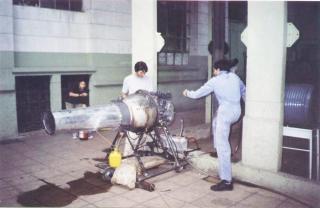 We maintained that regime by approximately 45 seconds by two
reasons: The exhaust gases' temperature measurement system had failed and
there was no reading, and not less worrisome, we noticed that the exhaust jet
tube was changing of coloration quickly in the neighborhoods of the zone of
the turbine blades. We had already reached again much more far from which at first seemed possible.
We cut off the JP-1 feeding to the turbojet, and in a somewhat strange way,
since the remaining fuel that was within the feed pipes made difficulties in
this task.
We maintained that regime by approximately 45 seconds by two
reasons: The exhaust gases' temperature measurement system had failed and
there was no reading, and not less worrisome, we noticed that the exhaust jet
tube was changing of coloration quickly in the neighborhoods of the zone of
the turbine blades. We had already reached again much more far from which at first seemed possible.
We cut off the JP-1 feeding to the turbojet, and in a somewhat strange way,
since the remaining fuel that was within the feed pipes made difficulties in
this task.
We had already been warned about this problem by the people of E.T. Taller Regional Quilmes, but it was evident that we did not solve things well.
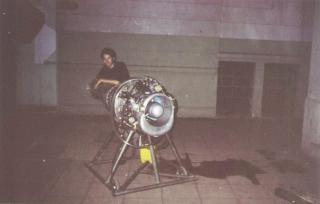 Now yes. Hugs and celebrations. 18 years later, were it not by the new
students generations, would it be fortuituous that the same people be unite
around a similar goal in still more adverse work conditions?. Time did not do more than
to confirm all our feelings on the matter, and it is for that reason that we are
going to insist until we manage to construct the lacking auxiliary systems
and to make a mini-installation to measure the thrust of the turbojet.
Now yes. Hugs and celebrations. 18 years later, were it not by the new
students generations, would it be fortuituous that the same people be unite
around a similar goal in still more adverse work conditions?. Time did not do more than
to confirm all our feelings on the matter, and it is for that reason that we are
going to insist until we manage to construct the lacking auxiliary systems
and to make a mini-installation to measure the thrust of the turbojet.
Because we are Mechanical Technicians above all... And we are proud of it also in 2000.